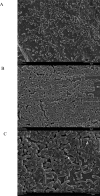Enhanced biofilm formation in dual-species culture of Listeria monocytogenes and Ralstonia insidiosa
- PMID: 31294188
- PMCID: PMC6604966
- DOI: 10.3934/microbiol.2017.4.774
Enhanced biofilm formation in dual-species culture of Listeria monocytogenes and Ralstonia insidiosa
Abstract
In the natural environments microorganisms coexist in communities as biofilms. Since foodborne pathogens have varying abilities to form biofilms, investigation of bacterial interactions in biofilm formation may enhance our understanding of the persistence of these foodborne pathogens in the environment. Thus the objective of this study was to investigate the interactions between Listeria monocytogenes and Ralstonia insidiosa in dual species biofilms. Biofilm development after 24 h was measured using crystal violet in 96-well microtiter plate. Scanning electron microscopy and cell enumeration were employed after growth on stainless steel coupons. When compared with their single species counterparts, the dual species biofilms exhibited a significant increase in biofilm biomass. The number of L. monocytogenes in co-culture biofilms on stainless steel also increased significantly. However, there was no effect on the biofilm formation of L. monocytogenes when cultured with R. insidiosa separated by a semi-permeable membrane-linked compartment or cultured in R. insidiosa cell-free supernatant, indicating that direct cell-cell contact is critical for this interaction.
Keywords: Listeria monocytogenes; Ralstonia insidiosa; biofilm.
Conflict of interest statement
Conflict of Interest: All authors declare no conflicts of interest in this paper.
Figures



Similar articles
-
Genes involved in Listeria monocytogenes biofilm formation at a simulated food processing plant temperature of 15 °C.Int J Food Microbiol. 2016 Apr 16;223:63-74. doi: 10.1016/j.ijfoodmicro.2016.02.009. Epub 2016 Feb 11. Int J Food Microbiol. 2016. PMID: 26900648
-
Dynamics of biofilm formation by Listeria monocytogenes on stainless steel under mono-species and mixed-culture simulated fish processing conditions and chemical disinfection challenges.Int J Food Microbiol. 2018 Feb 21;267:9-19. doi: 10.1016/j.ijfoodmicro.2017.12.020. Epub 2017 Dec 19. Int J Food Microbiol. 2018. PMID: 29275280
-
Effects of environmental parameters on the dual-species biofilms formed by Escherichia coli O157:H7 and Ralstonia insidiosa, a strong biofilm producer isolated from a fresh-cut produce processing plant.J Food Prot. 2015 Jan;78(1):121-7. doi: 10.4315/0362-028X.JFP-14-302. J Food Prot. 2015. PMID: 25581186
-
An ecological perspective of Listeria monocytogenes biofilms in food processing facilities.Crit Rev Food Sci Nutr. 2013;53(8):801-17. doi: 10.1080/10408398.2011.561378. Crit Rev Food Sci Nutr. 2013. PMID: 23768144 Review.
-
Intra- and inter-species interactions within biofilms of important foodborne bacterial pathogens.Front Microbiol. 2015 Aug 20;6:841. doi: 10.3389/fmicb.2015.00841. eCollection 2015. Front Microbiol. 2015. PMID: 26347727 Free PMC article. Review.
Cited by
-
Synergistic interactions in multispecies biofilm combinations of bacterial isolates recovered from diverse food processing industries.Front Microbiol. 2023 Apr 13;14:1159434. doi: 10.3389/fmicb.2023.1159434. eCollection 2023. Front Microbiol. 2023. PMID: 37125177 Free PMC article.
-
Characterizing Biofilm Interactions between Ralstonia insidiosa and Chryseobacterium gleum.Microbiol Spectr. 2023 Feb 6;11(2):e0410522. doi: 10.1128/spectrum.04105-22. Online ahead of print. Microbiol Spectr. 2023. PMID: 36744887 Free PMC article.
-
Unveiling Ralstonia spp. in the Neonatal Intensive Care Unit: Clinical Impacts and Antibiotic Resistance.Antibiotics (Basel). 2025 Mar 3;14(3):259. doi: 10.3390/antibiotics14030259. Antibiotics (Basel). 2025. PMID: 40149070 Free PMC article.
-
Identification and Elimination of the Clinically Relevant Multi-Resistant Environmental Bacteria Ralstonia insidiosa in Primary Cell Culture.Microorganisms. 2020 Oct 17;8(10):1599. doi: 10.3390/microorganisms8101599. Microorganisms. 2020. PMID: 33080836 Free PMC article.
-
Outbreak of Ralstonia bacteraemia among chronic kidney disease patients in a haemodialysis unit in the Philippines.Western Pac Surveill Response J. 2022 Dec 27;13(4):1-6. doi: 10.5365/wpsar.2022.13.4.960. eCollection 2022 Oct-Dec. Western Pac Surveill Response J. 2022. PMID: 36817499 Free PMC article.
References
-
- Sauer K, Rickard AH, Davies DG. Biofilms and biocomplexity. Microbe. 2007;2:347.
-
- Da SEP, De Martinis ECP. Current knowledge and perspectives on biofilm formation: the case of Listeria monocytogenes. Appl Microbiol Biot. 2013;97:957–968. - PubMed
-
- Elias S, Banin E. Multi-species biofilms: living with friendly neighbors. FEMS Microbiol Rev. 2012;36:990–1004. - PubMed
-
- Ferreira V, Wiedmann M, Teixeira P, et al. Listeria monocytogenes persistence in food-associated environments: epidemiology, strain characteristics, and implications for public health. J Food Protect. 2014;77:150–170. - PubMed
LinkOut - more resources
Full Text Sources
